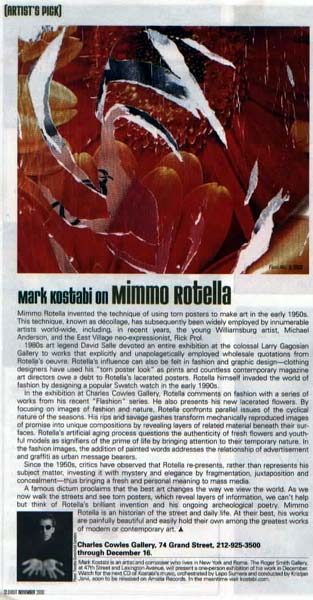Mark Kostabi on Mimmo Rotella

Mimmo Rotella invented the technique of using torn posters to make art in the early 1950s. This technique, known as decollage, has subsequently been widely employed by innumerable artists world-wide, including, in recent years, the young Williamsburg artist, Michael Anderson, and the East Village new-expressionist, Rick Prol.
1980s art legend David Salle devoted an entire exhibition at the colossal Larry Gagosian Gallery to works that explicitly and unapolagetically employed wholesale quotations from Rotella’s oeuvre. Rotella’s influence can also be felt in fashion and graphic design—clothing designers have used his “torn poster look” as prints and countless contemporary magazine art directors owe a debt to Rotella’s lacerated posters. Rotella himself invaded the world of fashion by designing a popular Swatch watch in the early 1990s.
In the exhibition at Charles Cowles Gallery, Rotella comments on fashion with a series of works from his recent “Flashion” series. He also presents his new lacerated flowers. By focusing on images of fashion and nature, Rotella confronts parallel issues of the cyclical nature of the seasons. His rips and savage gashes transform mechanically reproduced images of promise into unique compositions by revealing layers of related material beneath their surfaces. Rotella’s artificial aging process questions the authenticity of fresh flowers and youthful models as signifiers of the prime of life by bringing attention to their temporary nature. In the fashion images, the addition of painted words addresses the relationship of advertisement and graffiti as urban message bearers.
ISince the 1950s, critics have observed the Rotella re-presents, rather than represents his subject matter, investing it with mystery and elegance by fragmentation, juxtaposition and concealment—thus bringing a fresh and personal meaning to mass media.
A famous dictum proclaims that the best art changes the way we view the world. As we now walk the streets and see torn posters, which reveal layers of information, we can’t help but think of Rotella’s brilliant invention and his ongoing archeological poetry. Mimmo Rotella is an historian of the street and daily life. At their best, his works are painfully beautiful and easily hold their own among the greatest works of modern or contemporary art.
November 2000